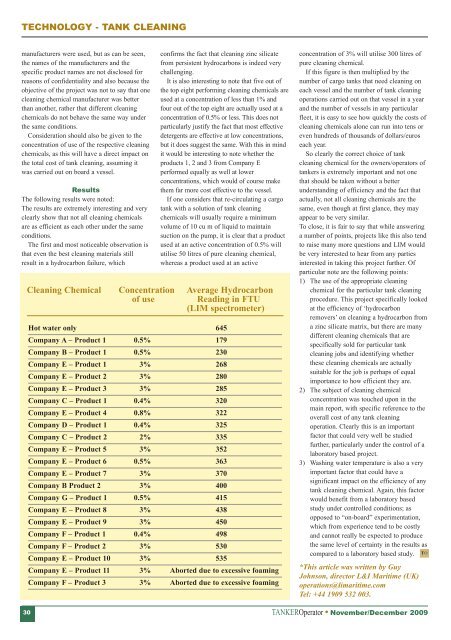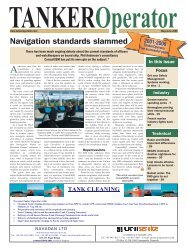Features: - Tanker Operator
Features: - Tanker Operator
Features: - Tanker Operator
Create successful ePaper yourself
Turn your PDF publications into a flip-book with our unique Google optimized e-Paper software.
TECHNOLOGY - TANK CLEANING<br />
manufacturers were used, but as can be seen,<br />
the names of the manufacturers and the<br />
specific product names are not disclosed for<br />
reasons of confidentiality and also because the<br />
objective of the project was not to say that one<br />
cleaning chemical manufacturer was better<br />
than another, rather that different cleaning<br />
chemicals do not behave the same way under<br />
the same conditions.<br />
Consideration should also be given to the<br />
concentration of use of the respective cleaning<br />
chemicals, as this will have a direct impact on<br />
the total cost of tank cleaning, assuming it<br />
was carried out on board a vessel.<br />
Results<br />
The following results were noted:<br />
The results are extremely interesting and very<br />
clearly show that not all cleaning chemicals<br />
are as efficient as each other under the same<br />
conditions.<br />
The first and most noticeable observation is<br />
that even the best cleaning materials still<br />
result in a hydrocarbon failure, which<br />
confirms the fact that cleaning zinc silicate<br />
from persistent hydrocarbons is indeed very<br />
challenging.<br />
It is also interesting to note that five out of<br />
the top eight performing cleaning chemicals are<br />
used at a concentration of less than 1% and<br />
four out of the top eight are actually used at a<br />
concentration of 0.5% or less. This does not<br />
particularly justify the fact that most effective<br />
detergents are effective at low concentrations,<br />
but it does suggest the same. With this in mind<br />
it would be interesting to note whether the<br />
products 1, 2 and 3 from Company E<br />
performed equally as well at lower<br />
concentrations, which would of course make<br />
them far more cost effective to the vessel.<br />
If one considers that re-circulating a cargo<br />
tank with a solution of tank cleaning<br />
chemicals will usually require a minimum<br />
volume of 10 cu m of liquid to maintain<br />
suction on the pump, it is clear that a product<br />
used at an active concentration of 0.5% will<br />
utilise 50 litres of pure cleaning chemical,<br />
whereas a product used at an active<br />
Cleaning Chemical Concentration Average Hydrocarbon<br />
of use Reading in FTU<br />
(LIM spectrometer)<br />
Hot water only 645<br />
Company A – Product 1 0.5% 179<br />
Company B – Product 1 0.5% 230<br />
Company E – Product 1 3% 268<br />
Company E – Product 2 3% 280<br />
Company E – Product 3 3% 285<br />
Company C – Product 1 0.4% 320<br />
Company E – Product 4 0.8% 322<br />
Company D – Product 1 0.4% 325<br />
Company C – Product 2 2% 335<br />
Company E – Product 5 3% 352<br />
Company E – Product 6 0.5% 363<br />
Company E – Product 7 3% 370<br />
Company B Product 2 3% 400<br />
Company G – Product 1 0.5% 415<br />
Company E – Product 8 3% 438<br />
Company E – Product 9 3% 450<br />
Company F – Product 1 0.4% 498<br />
Company F – Product 2 3% 530<br />
Company E – Product 10 3% 535<br />
Company E – Product 11 3% Aborted due to excessive foaming<br />
Company F – Product 3 3% Aborted due to excessive foaming<br />
concentration of 3% will utilise 300 litres of<br />
pure cleaning chemical.<br />
If this figure is then multiplied by the<br />
number of cargo tanks that need cleaning on<br />
each vessel and the number of tank cleaning<br />
operations carried out on that vessel in a year<br />
and the number of vessels in any particular<br />
fleet, it is easy to see how quickly the costs of<br />
cleaning chemicals alone can run into tens or<br />
even hundreds of thousands of dollars/euros<br />
each year.<br />
So clearly the correct choice of tank<br />
cleaning chemical for the owners/operators of<br />
tankers is extremely important and not one<br />
that should be taken without a better<br />
understanding of efficiency and the fact that<br />
actually, not all cleaning chemicals are the<br />
same, even though at first glance, they may<br />
appear to be very similar.<br />
To close, it is fair to say that while answering<br />
a number of points, projects like this also tend<br />
to raise many more questions and LIM would<br />
be very interested to hear from any parties<br />
interested in taking this project further. Of<br />
particular note are the following points:<br />
1) The use of the appropriate cleaning<br />
chemical for the particular tank cleaning<br />
procedure. This project specifically looked<br />
at the efficiency of ‘hydrocarbon<br />
removers’ on cleaning a hydrocarbon from<br />
a zinc silicate matrix, but there are many<br />
different cleaning chemicals that are<br />
specifically sold for particular tank<br />
cleaning jobs and identifying whether<br />
these cleaning chemicals are actually<br />
suitable for the job is perhaps of equal<br />
importance to how efficient they are.<br />
2) The subject of cleaning chemical<br />
concentration was touched upon in the<br />
main report, with specific reference to the<br />
overall cost of any tank cleaning<br />
operation. Clearly this is an important<br />
factor that could very well be studied<br />
further, particularly under the control of a<br />
laboratory based project.<br />
3) Washing water temperature is also a very<br />
important factor that could have a<br />
significant impact on the efficiency of any<br />
tank cleaning chemical. Again, this factor<br />
would benefit from a laboratory based<br />
study under controlled conditions; as<br />
opposed to “on-board” experimentation,<br />
which from experience tend to be costly<br />
and cannot really be expected to produce<br />
the same level of certainty in the results as<br />
compared to a laboratory based study. TO<br />
*This article was written by Guy<br />
Johnson, director L&I Maritime (UK)<br />
operations@limaritime.com<br />
Tel: +44 1909 532 003.<br />
30<br />
TANKER<strong>Operator</strong> November/December 2009

















